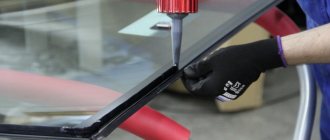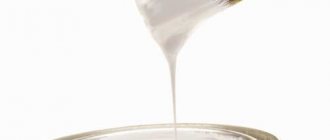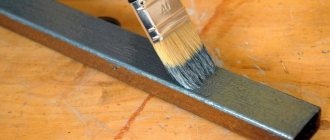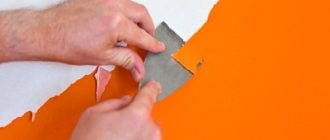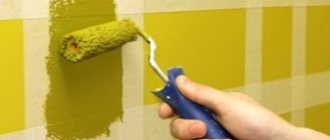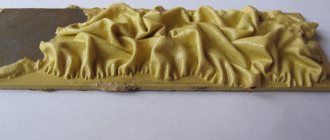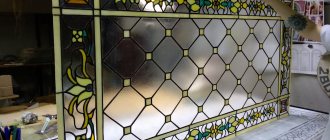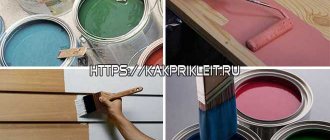05 November 2019
A popular finishing material is paint, which reliably protects the surface of plastic and wood for a long time. But over time, the appearance is lost and a rhetorical question arises: how to remove old paint from the walls. Moreover, those who have tried to do this mechanically know that the bathtub coating can be ruined. Also, during the construction or renovation of a residential premises, window sills, sockets, walls, switches, etc. may be damaged by paint and varnish materials. The “paint” problem can be solved if you know the characteristics of the surface and the composition of the substance. The common thermal method is also not an option for plastic, since the product may “lead.” It remains to turn to the chemical method.
Mechanical cleaning
This method is quite suitable for use at home: it does not require complex equipment or special skills. To clean the glass you will need:
- hot water;
- dishwashing liquid;
- a piece of clean cloth;
- blade or sharpened thin knife.
You can use a stationery knife, as well as a special scraper of the required size. If you don’t have anything at hand, then a hard metal dishwasher will do.
To begin, dissolve the detergent in a container of hot water and moisten the old paint on the glass with this solution. To prevent moisture from getting on freshly painted wooden window sills, they must be covered with film.
Scraping paint should be done at an optimal angle of 45 degrees. This will avoid the formation of cracks and scratches.
Removing drops of paint from glass is done with gentle movements and in one direction, periodically removing dirt from the blade. If the drop is wet enough, the stain will come off easily. Do not constantly move the tool from side to side - this will easily scratch the window glass.
The sound that the blade should make cannot be anything like grinding or squeaking. This may indicate a dull tool. In this case, it should be changed.
After the plastic window has been completely cleared of paint, they begin to wash the glass using a special product with a spray bottle.
Use of solvents
The easiest way to remove traces of paint from window glass is to use solvents.
| Pros of using solvents | Disadvantages of using solvents |
| · high efficiency; | · additional financial costs for the purchase of solvents; |
| · speed; | · When working, it is necessary to observe safety precautions. |
| · safety for glass surfaces. |
The choice of solvent depends on the type of paint.
For oil paints use:
- Petrol. Widely used solvent. To clean glass, you should purchase purified gasoline, for example for lighters. Refined kerosene will have a similar effect.
- Turpentine. A substance of complex composition, suitable for removing traces of not only oil-based paints, but also alkyd-styrene paints.
- White Spirit. The solvent is used to dissolve oil and enamel paints.
For other types of paints the following solvents are needed:
- Acetone. Suitable for removing traces of perchlorovinyl paints.
- Solvent No. 646. Cleans acrylic paints and epoxy varnishes well.
- Solvent No. 647. It will help wash off nitro enamel from glass.
When using solvents, you need to make sure that these liquids do not get on the plastic parts of the frames and window sills. Acetone is especially dangerous in this regard: it can seriously damage plastic. Therefore, it is worth covering the window sill in advance with several layers of newspapers or film. Such a protective measure will be sufficient.
If the marks on the window are old, then it is not easy to determine the type of paint from them. In this case, it is recommended to use a universal paint remover. Another almost universal substance that dissolves most paints is toluene. But it belongs to the toxic category, so it requires caution when used.
Scraping paintwork
If there is a need to renew wooden frames, then it is worth preparing the surfaces before painting. The wood needs to be cleaned so that it is smooth, without any pieces of peeling paint. Then the new window covering will not come off after a short time.
The most common construction tool used for these purposes is a spatula.
Sometimes a metal sponge is used for dishes. It allows you to clean the window surfaces upon completion of the main work.
When wood frames are first painted, it is likely that the factory finish was polyurethane paint. In this case, before cleaning, the frames are wiped with soapy water and treated with sandpaper. Next, you can apply a special primer to make the paint stick better to the window.
A rather interesting method is to burn old paint from the window frame. Using a special cylinder, the coating layer is heated with a flame. Next, the wooden frames are cleaned with a spatula, and the remaining irregularities are removed with coarse sandpaper. Before painting, cracks in the wood are puttied and cleaned using a sanding machine.
Features of washing PVC windows
Cleaning plastic windows after renovation in a new building cannot be done in a hurry, rushing to finish the process as quickly as possible. Although the procedure is much faster and simpler than washing wooden frames, it is still important to follow certain rules.
There are several recommendations that allow you to properly clean your window without scratches, cracks, stains, or streaks:
- Before work, you need to take a soft, lint-free cloth, which often remains on the surface during washing. You will also need microfiber cloths and newspapers to clean windows.
- At the first stage, it is important to clean the outside of the window, then the inside. After washing the glass surface, proceed to washing the frame, fittings and only then the window sill.
- You should plan your work on a cloudy day, in the morning or evening.
- It is prohibited to use alkalis or abrasive powders.
- When using solvents, do not forget about protective equipment (goggles, gloves, mask).
Attention! Before washing windows, sweep away dust and debris with a rag or vacuum cleaner.
Cleaning with chemicals
The chemical method of cleaning plastic windows has a number of advantages:
- ease of use;
- achieving high results;
- Possibility of removing stubborn or stubborn stains.
The main means of this method is the so-called wash. It can be purchased at any hardware store. You can familiarize yourself with the use of such a chemical on the label, but the principle of use is almost the same:
- Before removing the old paint from the window, it is worth carrying out preparatory work: clean the glass surfaces from visible dirt and dust.
- A remover is applied to the paint stains. The solution must remain on the dirt for some time so that the coating can swell.
- After curing, remove the peeling paint from the glass with a construction spatula or scraper and wipe the surface with a solvent.
- Finally, the plastic windows are washed with a solution prepared using water and vinegar.
The most convenient form of removing old paint is a paste - it does not run off the glass.
Possible methods
Glass is a fragile material, but hard and chemically inert. Therefore, in order to wash paint off glass, you can use different methods:
- The simplest one is mechanical. Since glass is usually scratch-resistant, it can be rubbed with hard sponges or even scraped with a knife.
- Sometimes, to facilitate the process of mechanical removal of smears and drops, preheating is used. But here you need to be careful: a sharp temperature change can cause the glass to burst.
- The chemical method is less labor-intensive. Glass can be treated with various solvents; it will not cause any harm.
Homemade solutions
There is not always available cash to purchase special chemicals for cleaning paint. Ingenuity and skillful hands will come to the rescue. Homemade solution consists of:
- caustic soda;
- slaked lime;
- crushed chalk
First, mix lime and chalk until smooth, and then add soda. The ideal consistency should look like thick sour cream.
Apply the prepared paste to the stains and leave the mixture for several hours. After the specified time has passed, you can easily remove the dirt with a spatula. The method is considered inexpensive compared to thermal and chemical ones.
How to choose what is best to clean a window?
The choice of method is determined by:
- the extent of the affected surface;
- how old the blots and drips are.
For fresh stains, simply using a damp cloth will solve the problem. And you will have to tinker with old traces of staining using the above methods.
For small stains, a mechanical method is suitable to remove splashes from the surface . In case of significant staining of glass with paint, chemical and thermal methods are suitable. High temperature treatment can also be used for old multi-layer stains.
When exposed to chemical reagents, it is necessary to strictly follow safety precautions and prevent solvents from getting on the frame and window sill. When working with windows, the use of solvents in a spray is undesirable, since it is difficult to control the coverage area.
Very often it is necessary to use several methods , combining them to obtain the best result.
Thermal method
This method is usually used if:
- The stains are quite old.
- Window stains have become very dry or difficult to remove.
- The surface to be cleaned is large.
- The paint layer is quite thick.
The tool used for this method is a regular hair dryer. But if you don’t have such a device, you can use an iron.
Naturally, before using high temperatures, the glass must be cleaned and degreased.
A heat gun is brought at a slight angle to the surface of the stain and waited until bubbles form. After this, the paint that has peeled off the windows is carefully removed with a spatula.
If you use a regular iron, then place a piece of foil on the stain and only then begin to heat the stain with an electric device.
How to remove paint from walls and ceilings
When to remove paint from walls and ceilings
It is necessary to remove paint from the walls when you plan to decorate the walls with tiles or wallpaper. Or before leveling the walls with plaster. The painted surface does not have sufficient adhesion.
There is no need to remove the paint if you are going to cover the surfaces with a similar composition. To reliably apply a new paint coating, in most cases it is enough to choose the right primer, which will act as an adhesive layer.
There are a number of methods, the use of which separately or in combination with each other allows you to get rid of old paint. These include mechanical, chemical and thermal removal methods. The use of a specific technique depends on several factors:
2. Surface type:
3. Planned design of walls and ceiling. For example, if the task is to lay tiles, then high-quality cleaning of the walls from paint will be required, but if we are talking about wall panels, then it is enough to remove the paint only in places where it lags behind.
Unfortunately, the most difficult thing to remove paint is, as a rule, from a concrete unplastered surface, but such cases occur most often. In this regard, let's look at the main methods for removing paint from concrete surfaces - walls and ceilings. If you are reading this article in some other group, we recommend that you find the Book of Repairs group, where similar articles are published earlier.
Purely mechanical work
The most common, effective and safe, but also the most labor-intensive method of removing paint is mechanical. Its implementation can be different - both using hand tools (axe, spatula, chisel) and power tools (grinder, hammer drill or drill), including with special attachments. Since such work is associated with a large amount of dust and particles flying off the walls, you should always wear goggles and a respirator to protect your face and respiratory organs when carrying out this work.
"Old-fashioned" methods. Axe, chisel and spatula
One of the oldest methods of removing paint is to use a small ax to make frequent cuts to break the integrity of the paint layer. After this, warm water is sprayed onto the surface, the paint and the base underneath get wet, and then it will be much easier to remove it using the same ax.
If working with an ax quickly leads to physical fatigue, and the layers of paint adhere weakly and peel off from the surface, then you can use a chisel with a hammer. If the paint practically does not stick, feel free to take a spatula instead of a chisel and clean off the layer without a hammer. It’s even easier to scrape off paint by applying liquid glass to the wall or ceiling, which breaks the paint layer when it dries.
Grinder, drill and hammer drill
If you are not afraid of colossal amounts of dust, and your neighbors are tolerant of noise, the work will speed up significantly when using an angle grinder equipped with a wide range. The process will be long - on average, for every minute of such work there is a wait of two dozen minutes until the dust settles. On the other hand, the dust problem has now been partially solved - equipment is sometimes equipped with dust-suction units. As for drills and hammer drills, for such work they can be equipped with special attachments - paint removers. You can use brushes and crown attachments for working on brick - all these tools will be effective in removing paint from concrete.
Pros and cons of chemistry
Another group of methods includes chemical ones, which are based on weakening the paint layer by exposure to aggressive substances. Of course, this is easier than scraping walls and ceilings with an ax. However, after chemical treatment of surfaces, the softened paint will also have to be scraped off. There are certain restrictions on the use of these methods. In particular, old and strong paint and varnish coatings are weakly destroyed when exposed to solvents or special removers.
In addition, working with aggressive components can lead to poisoning, burns or allergic reactions, therefore increased safety requirements are put forward for the implementation of these activities - the use of protective suits, goggles and respirators. There will be an unpleasant odor in the room for a long time after finishing work. Also, chemicals are often expensive and require special disposal.
If, nevertheless, you have chosen the chemical “way” of cleaning walls and ceilings from paint, then in this case, regardless of the chosen chemicals, you need to perform the following steps:
- Apply the product to the surface with a paint roller or brush.
2. Wait until the paint layer softens.
3. Remove the paint with a spatula or scraper, or a wire brush.
The paint softening procedure may have to be repeated several times. What chemicals can be used? Mostly three types of compositions are used:
— Ready-made branded washes that are commercially available.
— Organic solvents, including acetone and white spirit.
— A mixture of quicklime and potassium carbonate or sodium carbonate (soda) in a 3:1 ratio. This composition is used only in cases where the paint does not adhere well to the surface.
High temperature method
No less dangerous than the chemical method, but still not as energy-consuming as the mechanical method, is the thermal method, which involves exposing the paint layer to high temperatures. This process uses a blowtorch or a hair dryer.
Using thermal paint removal technology involves heating the paint layer until it becomes covered with bubbles. If they are not available, a burner or hair dryer can be replaced with an iron, heating the paint layer through the foil. After swelling, this coating is removed with a spatula, any scraper or wire brush.
However, the efficiency of the work is often low - the paint will peel off only if the walls or ceiling are heated to a high temperature, which is difficult to achieve with a hair dryer in the case of a concrete surface.
Useful tips
To achieve maximum efficiency when removing paint from plastic windows, you should use some rules:
- Before painting, lubricate surfaces on which you do not want paint to come in contact with a thick layer of laundry soap - this will make it much easier to wash away stains.
- When heating the paintwork, the main thing is not to overdo it, because the glass can crack.
- Before using washing solutions, it is necessary to ensure good air circulation: the pungent odor must dissipate during operation.
- Old acrylic-based paint can be easily removed with alcohol, and enamel is dissolved with acetone-containing substances.
The presented methods are quite effective in application. The main thing is to remember that the result depends on the correct use of the tool or chemical.
Painting on glass with washable paint
Preserve nature's works of art by frosting your windows with white, washable paint.
Window painting is a versatile activity that is often done for promotional purposes, holiday shows, school projects, or just plain old fun. The problem is, if you use the wrong paint, that fun art project can quickly turn into a cleanup nightmare when stubborn or hard-to-remove paint just won't wash off. Learn how to make your own washable paint for windows, mirrors and other glass surfaces if you need a temporary design that's easy to remove later. The recipe is easy to make, easy to paint with, and will allow your creative genius to come to life without worry or fear tough or messy cleaning later.
.
Whitewash
Dry whitewash on glass and plastic can be easily wiped off with a dry rag; using a wet rag will only spread the dirt and will take a long time to wash away stains and drips. After you have removed most of the whitewash with a dry cloth, you can start cleaning the window. The plastic profile is washed with soapy water, and the glass is washed with window cleaner or homemade detergent (for 2 liters of water, 1 tablespoon of ammonia or 2 tablespoons of vinegar).
Things are not so good with lime whitewash; it won’t go away that easily. It can be removed from glass with a blade or a stationery knife. In order to wash off lime from PVC windows, use one of the suggested means:
- Cillit , dilute with water one to one and apply to the stained surface, after a few minutes scrub with a hard washcloth. Be careful, Cillit contains oxalic acid, test in a hidden place before use.
- Dissolve a tablespoon of vinegar or citric acid in a bucket of water and wash the profile.
- Table salt also helps get rid of lime. A glass of salt on a bucket of water.
- Instead of salt and vinegar, you can add vegetable oil to the water: 100 g. for 10 l. water, the same composition is used to wash dirty floors, vinyl wallpaper and even wooden furniture. After the whitewash has been washed, the surfaces are degreased with dishwashing liquid. Lacquered furniture is not degreased, but polished with a soft cloth.
Wallpaper glue is easily washed off with warm water.
Protective film
Some owners neglect the instructions and do not remove the protective tape, explaining that the repair is not yet completed and the plastic profile needs to be protected from stains and construction dust. This is of course true, but over time the glue changes its properties and the film tightly “sticks” to the frame. It’s better to remove it immediately and stick on masking tape, which can be easily removed and protects it from dirt just as well.
If you didn’t know this, and the film has managed to stick tightly, then use one of the suggested means:
- Construction hair dryer and scraper for metal-ceramic plates. It is necessary to heat the film and remove it with a scraper for cleaning metal-ceramic stoves.
- Scrape off pieces of film with a blade or a stationery knife, and erase the remains with an eraser. It will take quite a long time to clean, but the result will not disappoint you.
- If the film has crumbled, then washing it can be quite difficult. White spirit or technical alcohol will be useful for this work Apply the product to the pieces of film, wait a few minutes and scrub thoroughly with a brush with stiff bristles (do not use a metal one!)
- Another way to remove small pieces is to stick wide tape over it, press it well, smooth it out, wait an hour and tear it off along with the stuck pieces of film.
For detailed instructions on how to remove the remaining protective film from a plastic profile, please follow the link.
Sometimes such an unpleasant situation happens: the film is removed, and inscriptions, sticky traces of glue and paint are imprinted on the frame. Over time, dust will settle on the glue, and the windows will look absolutely terrible. What to do in this situation?
First, try to wash off the glue stains with water with the addition of dish soap, soap or washing powder, and rub thoroughly with the hard side of the sponge. If traces remain, then you will have to go to a hardware store and buy a special composition for removing glue: Mellerud, SOLINS, Antiscotch, and the like.
Use the products strictly according to the instructions, wear protective gloves. Before applying it to the entire window, try it in an inconspicuous place; if the plastic has not changed color and its gloss has not faded, then you can apply it to the front part of the frame.
If the letters are printed and cannot be washed off with soapy water, alcohol, or chlorine bleach, you will have to use Cosmofen 20 plastic solvent, which can be purchased at a hardware store or at the company where you ordered the windows.
Be careful: Cosmofen 5, 10 and 20 are on sale; the lower the number, the stronger the solvent. For example: No. 5 dissolves plastic too much; it is used to remove deep scratches, but more on that below.
In our case, we need twenty - in its properties it is more similar to plastic polish. You need to apply a little product to a soft white cloth (make sure that the rag does not leave lint) and rub lightly to remove traces of paint. Finally, gently polish the area using circular motions.
You might be interested in learning how to whiten yellowed plastic windows.
Attention! Use " Cosmofen " and similar products from other brands only as a last resort, if household chemicals are powerless. Some types of plastic may change color when exposed to solvents or lose their gloss.
Recommendations from experts
When starting to remove paint from the glass surface, you need to consider the following points:
- It is easier to remove a fresh paint layer than an old one.
When working with solvents, it is necessary to ensure good ventilation in the room and use rubber gloves, a respirator, and special goggles for protection.- Before using a solvent, you need to study the instructions for the product and make sure that it is intended for removing a specific type of paint.
- In order to reduce the likelihood of paint getting on the glass, it is advisable to protect the window before painting. For example, smearing it with a thick soap solution. In the future, accidentally spilled paint will be easy to wash off.
- You cannot mix several types of solvents in one area.
If it is possible to position the glass horizontally when cleaning, it will be more convenient to work with it.
How to remove paint from plastic windows
After the finishing work is completed, stains and drips from construction mixtures often remain on plastic windows. The polyurethane foam needs to be cut off and the remaining residues removed with Dimexide, White Spirit or a special remover. The protective film is removed using a scraper and a hair dryer, and the remaining adhesive is dissolved with alcohol. Paint, putty and whitewash can be cleaned with a spatula or using household chemicals. We will tell you how to clean windows after repair and remove scratches from the plastic profile.
The finishers have finished their work, but before the house begins to shine clean, it is necessary to remove construction debris and wash all surfaces from stains of paint, putty and lumps of foam. First, let's deal with the windows: first of all, we'll remove the protective film, usually this is done in one motion, but if the windows were installed a long time ago and no one removed the film, then you'll have to tinker.
Liquid Nails
It is extremely rare for liquid nails to end up on a frame or window sill. If this happens, it will take you a long time to scrape off the brown spots. There are two types of liquid nails: water-based and solvent-based. The composition can be read on the product packaging.
It is recommended to wash off liquid nails with acetone, but this will not work for us, because acetone spoils the plastic.
Water-based liquid nails are designed for interior use. They lose their sticky qualities when heated and frozen, then they can be easily removed with a spatula or the back of a dish sponge. For heating, you can use a steam generator, a hair dryer or a regular hair dryer. And to freeze the composition, use ice from the freezer or a spray to remove plasticine and chewing gum: Pramol GUMEX, ANTI-GUM or pharmacy ICEMIX.
The solvent-based composition can be removed with a wallpaper knife. Manufacturers recommend solvents No. 646, 647, 648 as a remover ( absolutely cannot be used for plastic windows! ), mineral solvent (usually consists of water and organic compounds, you can try on an inconspicuous area, if it does not spoil the plastic, use it, the same goes for turpentine and white spirit). You can try to wipe off any glue residue with nail polish remover without acetone.
Some types can be washed with alcohol. Liquid nails from different companies vary greatly in their composition, which is why we cannot give a single recipe.
How to wash balcony windows from the outside.
Polyurethane foam
If the team was not particularly careful, then after they leave you may encounter another problem: dried foam on the profile, window sill and glass. If the foam has frozen in a piece, then you can scrape it off with a spatula, and wash the remaining trace using improvised means. How to remove traces of polyurethane foam from a plastic window? We will briefly touch on this issue; for more details, click on the highlighted fragment.
- Sunflower oil . Fresh stains should be rubbed with a cloth soaked in hot vegetable oil. An old stain will take longer to remove. Rub and cover with an oiled rag after 30 minutes. the remaining foam will be much easier to wash off.
- Vinegar 9% . With a little effort, you can remove traces of foam.
- If the foam has not had time to harden, it can be easily washed off with “ White spirit ” or a liquid for washing a mounting gun that contains ethyl acetate. Apply the remover only with a white cloth, otherwise the dye will dissolve and be absorbed into the plastic, making it difficult to clean. But it is better to let the foam harden and remove it mechanically.
- “ Dimexide ” is a pharmaceutical product that is used by experienced builders to remove traces of polyurethane foam. You need to cut off the main part of the piece with a blade, moisten a cotton pad with dimexide and rub it well, put the disc on the stain and leave for 5-10 minutes. The foam will soften and easily separate from the plastic.
- You can use a homemade “wash”; for this you need to mix 10 grams of acetone and solvent A-649 , 20 grams. vinegar essence and 50 gr. liquids for washing construction guns. Installers claim that this composition dissolves any brand of polyurethane foam.
Source
